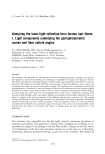270 JOURNAL OF COSMETIC SCIENCE antidandruff preparations. In addition, the effects of repeated washing with or without active ingredients (wash-out kinetics, saturation effects) could also be evaluated. REFERENCES (1) E. Gu•ho, T. Boekhout, H. R. Ashbee, et aL, The role of Malassezia species in the ecology of human skin and as pathogens, Med. MycoL, 36 (suppl. 1), 220-229 (1998). (2) G. Midgley, The lipophilic yeasts: State of the art and prospects, Med. Mycol., 38 (suppl. 1), 9-16 (2000). (3) E. Gu•ho, G. Midgley, and .J. Gulllot, The genus AJa/assezJa with description of four new species, Antonie van Leeuwenhoek, 69, 337-355 (1996). (4) J. Guillot, E. Gu•ho, M. Lesourd, et al., Identification of Malassezia species: A practical approach. J. Mycol. Mgd., 6, 103-110 (1996). (5) R.J. Hay and C. Graham-Brown, Dandruff and seborrheic dermatitis: Causes and management, Clin. Exp. Derm., 22, 3-6 (1997). (6) C. Pi•rard-Franchimont, J. F. Hermanns, H. Degreef, and G. E. Pi•rard, From axioms to new insights into dandruff, Dermatology, 200, 93-98 (2000). (7) R.D. Aron-Bruneti•re, D. Dompmartin-Pernot, and E. Drouhet, Treatment of pityriasis capiris (dandruff) with econazole nitrate, Acta Derm. Venereol., 57, 77-80 (1977). (8) L. C. Barber, The aetiology of dandruff. PR No. 8. Pityrosporum ovale/amphotericin B dandruffaetiology study (DA-125). Internal Report. Procter & Gamble, Cincinnati, 1977. (9) M.M. Carr, D. Pryce, and F.A. Ive, Treatment of seborrheic dermatitis of the scalp with 2% ketoconazole, Br. J. Dermatol., 116, 213-216 (1986). (10) S. Shuster, The aetiology of dandruff and mode of action of therapeutic agents, Br. J. DermatoL, 111, 235-242 (1984). (11) M. C. Y. Heng, C. L. Henderson, D.C. Barker, et aL, Correlation of Pityrosporum ovale density with clinical severity of seborrhoeic dermatitis assessed by a simplified technique, J. Am. Acad. DermatoL, 23, 82-86 (1990). (12) R. W. Van der Wyck and F. C. Roia, The relationship between dandruff and the microbial flora of the human scalp, J. Soc. Cosmet. Chem., 15, 761-768 (1964). (13) R. W. Van der Wyk and K. E. Hechemy, A comparison of the bacterial and yeast flora of the human scalp and their effect upon dandruff production,.]. Soc. Cosmet. Chem., 18, 629-639 (1967). (14) I.M. Bergbrant and J. Faergemann, Seborrhoeic dermatitis and Pityrosporum ova/e: A cultural and immunological study, Acta Derre. Venereol., 69, 332-335 (1989). (15) D.C. Clift, H. J. Dodd, J. D. T. Kirby, et aL, Seborrhoeic dermatitis and malignancy. An investigation of the skin flora, Acta Derre. VenereoL, 68, 48-52 (1988). (16) N.J. Van Abbe, The investigation of dandruff, J. Soc. Cosmet. Chem., 15, 609-630 (1964). (17) K.J. McGinley, L.J. Leyden, R. R. Marpies, et aL, Quantitative microbiology of the scalp in non- dandruff, dandruff, and seborrheic dermatitis, J. Invest. DermatoL, 64, 401•405 (1975). (18) P. Mayser and K. Grtinder, Growth inhibition of Malassezia species by pharmacological concentrations of polidocanol, Mycoses, 38, 23-27 (1995).
j. Cosmet. Sci., 54, 271-281 (May/June 2003) UV radiation: Aggressive agent to the hair--AFM, a new methodology of evaluation V. F. MONTEIRO, A. S. PINHEIRO, E.R. LEITE, J. A.M. AGNELLI, M. A. PEREIRA-DA-SILVA, and E. LONGO, CMDMC/LIEC/DQ/UFSCar (V.F.M., A.S.P., E.L.) and DEMa/UFSCar •.A.M.A.), Universidade Federal de S•7o Carlos, Rod Washington Luis Km 235, Caixa Postal, 676, S•7o Carlos, SP, Brazil 13565-905 and Universidade de S•7o Paulo, Instimto de Fisica, S•o Carlos, SP, Brazil 13560-970 (M.A.P.-D.-S.). Accepted for publication June 18, 2002. Synopsis A new method for morphological hair analysis at high resolution and under ambient conditions is presented in this paper. The AFM has been used in these experiments to analyze morphological changes in hair roughness and thickness after UV radiation. Through the powerful analytical AFM tools, changes in hair morphology can be proven. A new quantitative methodology to evaluate hair structure is presented in this paper. INTRODUCTION Constant investigations into technological development of hair care products that exceed consumers' expectance have long represented a challenge for researchers and scientists. Many investigations have been carried out to develop effective cosmetic products for human hair, and scientists have employed a variety of methods in their attempts to understand the alterations and to prove the cosmetic efficacy of the products. Recent reports on the harmful effects of sunlight on human skin have raised the aware- ness of the deleterious effect of sunlight on biological tissues in general. Hair can also suffer photo degradation (1), which can contribute significantly to overall hair damage (2). The influence of sunlight on untreated human hair has been extensively analyzed by examination of the protein, melanin, and lipid components as well as the morphological areas on irradiated hair (3). These studies have demonstrated that the physical and chemical modifications of hair are marked by intrinsic patterns of damage correlated to its pigmentation and to the amount and intensity of sunlight to which it has been exposed. UV-A and the visible part of sunlight (VIS) damage hair significantly however, hair's properties are also influenced to a minor extent by UV-B and IR irradiation. Black hair is largely protected from damage by the pigment eumelanin. In contrast, blonde 271
Purchased for the exclusive use of nofirst nolast (unknown) From: SCC Media Library & Resource Center (library.scconline.org)


























































































